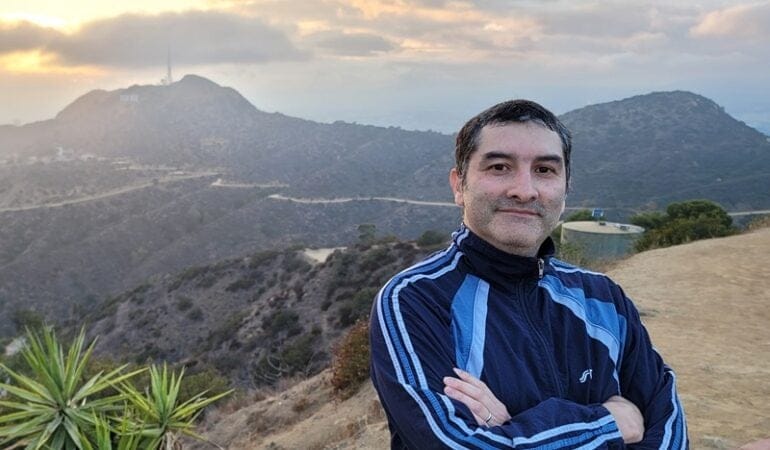Jacob Frey is an unabashed transplant. While attending law school at Villanova, the Virginia native and professional runner came to Minneapolis to run the Twin Cities Marathon and, as he tells it, fell in love with the city. The day after graduating, he drove the 1,200 miles west to Minneapolis, his chosen home.
He started as an employment and civil rights attorney, became a community organizer, served on the City Council, and was elected mayor in 2017, promptly faced with COVID and the police murder of George Floyd in 2020. He was re-elected in 2021 and continued to address police and race relations, as well as the connections among racial equity, affordability, and zoning.
Senior Fellow Anthony Flint interviewed Frey while visiting Minneapolis for the American Planning Association National Planning Conference. Frey later joined the Lincoln Institute and two other mayors from legacy cities—Aftab Pureval of Cincinnati and Paige Cognetti of Scranton—for a standing-room-only APA panel discussion about what’s working in legacy cities.
The interview, which has been edited for length, can be heard in full on the Land Matters podcast.
Anthony Flint: Minneapolis has been a pioneer in zoning reform and banning single-family-only zoning. How is it going? Can you talk a little bit about whether increasing supply is a good path to affordability?
Jacob Frey: There are two critical paths that you need to take simultaneously to achieve affordability. The first is subsidy. It’s bridging the gap between the market rate and the affordable rate, making sure that people who are experiencing homelessness have that next rung on the ladder to pull themselves out. That side of the equation can’t be achieved simply through supply; it requires some government intervention.
About 10 years ago when I first took office as a city council member, I said very clearly that we were going to go to war on surface parking lots. We were going to dramatically add supply and density, and we did. We coupled that with a comprehensive plan which, as you mentioned, got rid of single-family exclusive zoning, allowing duplexes and triplexes in residential neighborhoods, and then also adding density and height along commercial corridors.
All those things have allowed Minneapolis to keep rents down more than just about any other major city in the country. Other cities were seeing double-digit increases, where we were keeping our rent increases to 1 percent and 2 percent. That’s with a whole lot of new people moving in. We’ve dramatically increased supply and it’s helped a whole lot.
For years, we were operating under these prescriptive zoning ordinances that explicitly said, we’re going to keep the Blacks and the Jews in one portion of the city. When that became illegal to do explicitly, we then started to do the same stuff implicitly through the zoning code, making it so that unless you could own a huge home on a huge parcel, you couldn’t live in huge swaths of the city. The tails of those decisions continued to the present. We wanted to push back on that. We’re going for a diversity of housing options in every neighborhood, and therefore a diversity of people in every neighborhood. In the last three years, we’ve built over 1,000 housing units in multifamily buildings on parcels that previously would only allow a single-family home.
We’ve seen a whole lot of progress . . . and then we got sued. We’re going to ultimately win, whether through legislation or through the litigation itself. Everybody should have that opportunity to live in a great city, and we want to create that opportunity for everyone.
AF: For people outside of Minneapolis, who did you get sued by, and what was the rationale?
JF: We got sued by a group of people who said we were doing something that would harm the environment, and I adamantly disagree. One of the best ways to improve the environment, to reduce your individual carbon output, is by living in a great city. Rather than commuting 45 minutes into work from your own single-family home and picket fence out in the suburbs or exurbs, you can walk to the grocery store and take your bicycle to work. If you do take a car, well, it’s fewer miles traveled anyway. The suit is largely saying that we should have conducted an environmental review on this comprehensive plan and the total potential build-out. Let’s be real here. We can’t assume that every single building downtown is going to be 100 stories tall and every single-family home is going to be a triplex, because that is never going to happen. The way they were asking us to calculate this buildout is not operating in reality.
AF: Turning now to transit and mobility, how are you achieving your vision for sustainable mobility in a historically car-dependent metropolis?
JF: Our city was built out at a time when people were largely dependent on cars. To the extent that it was built out prior to that time period, the streets and the grids were shifted to make them car-centric. Of course, we recognize that cars are a way people get around, but we want to add options so people can safely and comfortably take their bike to work, we want to make it so that pedestrians feel comfortable and in fact are prioritized, we want to add public transportation, not just as an option that’s available occasionally, but as a convenient one for getting from point A to point B.
We are adding bus rapid transit wherever we can. We’ve seen a dramatic uptick in the number of BRT lines, and over the last 15 years, Minneapolis has grown by about 50,000 people, yet the total vehicle miles traveled and gas emissions have gone down.
We recognize that people are going to take cars and we’re going to try to make those cars as sustainable as possible through electric vehicle charging stations. Right now we’re adding bus-specific transit lanes as well so that you can take the bus and whip by traffic that you would otherwise be sitting in.

AF: What is your assessment of land-based financing to fund transit, redevelopment, affordable housing, and parks? The idea is that government action and investments create value in private land and development. Isn’t it possible to harness some portion of that increase in value and plow it back into the community? Are you a value capture fan?
JF: I think it’s not smart to be pro-value capture, pro-TIF, or anti–value capture, anti-TIF. It is a very important tool and needs to be balanced.
There is a way to enhance a city by using tools such as value capture and TIF to achieve wonderful structures and building and transportation options that would not happen but for government intervention. We’ve been using it in a number of different ways, including one of the most popular policy moves I’d say we’ve done in the last few years, which is to knock down this old Kmart. To take you back: 40 or 50 years [ago] there was a policy decision made to block off Nicollet Avenue and put a big Kmart in a huge parking lot in the middle of it.
It would be somewhat unfair of me to question decisions that were made at that time, because I’m sure 40 years from now, there are decisions I will have made that turn out to be not so smart, but this is one of the worst, in my opinion, urban planning decisions that was made in our city. We found ways to get land control over that former Kmart. We are knocking the building down. We’re opening up the street and breathing new life into this important artery and making sure everything is there, from a park to affordable housing to commercial to market rate. It allows the flow of entrepreneurship and new business growth on that corridor to expand south and north. A big part of what we’re using to achieve this large-scale goal is value capture.
It is a tool that should be used, but it’s also a tool that shouldn’t be used every single time there’s a new building that goes up or a new opportunity to be had. It’s got to be a balance.
AF: A task force is looking at changes to the Metropolitan Council, but in what ways is this pioneering arrangement working? Can or should it be replicable, this idea of regional governance?
JF: You can’t think about any city as living in a vacuum. Mayor Carter [of St. Paul] and I joke that it’s not like we just protect the water on our side of the Mississippi River. We share. Likewise, we share an economy that doesn’t end where the street ends and the boundary starts.
I’ve got a responsibility to the city of Minneapolis, and it helps to have a governing body that has a regional focus. We’ve got a Metropolitan Council appointed largely by the governor that helps us put up light rail that goes through a number of different municipalities. It helps us design bus-rapid transit, helps pay for Metropolitan Transit police. To have that regional focus is not just important; it’s crucial to furthering a regional mindset and goal.
AF: What’s your view on skyways? Current urban planning practices suggest a focus on the street and activity at the street level. Is there a conflict there? Tell us a little bit about the urban design part of your job.
JF: If you’ve got 100,000, 200,000 people coming downtown, and you’ve got two levels of activity, you’re splitting whatever number it is between those two levels.Do I like the splitting of activity? Of course I don’t. Nobody does. I’d rather have a concentration of all that bustle and excitement and vibrancy all on one level. But I use the skyways. During the months where it’s cold, I go in and I grab a sandwich and I don’t feel guilty about it. In fact, I’m really pumped to see the small local business owners that are operating in it.
Skyways have been hit particularly hard in the last few years because of a decrease in the number of workers that come downtown on an annual basis. I will not take any more criticism about the lack of vibrancy downtown or somebody’s favorite sandwich shop closing, from the person that’s sitting on their couch at home in the suburbs. If you care, then you should be supporting that sandwich shop.
If you want to see vibrance and want to see more foot traffic, your feet should be adding to that traffic. We are increasing the numbers pretty dramatically right now. People are definitely coming back, but it’s not happening all in one big burst.
AF: It’s become a bit of a cliche, but there really is no substitute for being in the office.
JF: It’s the unplanned interactions that ultimately help. I’m largely in Minneapolis because of a coincidence. You meet somebody, you get a job, you get an interview, you find a great city that you fall in love with. These things only happen because you were there to have it happen to you.
Anthony Flint is a senior fellow at the Lincoln Institute of Land Policy, host of the Land Matters podcast, contributing editor of Land Lines, and author of Mayor’s Desk: 20 Conversations with Local Leaders Solving Global Problems.
Lead image: Minneapolis Mayor Jacob Frey. Credit: Office of Mayor Frey.










